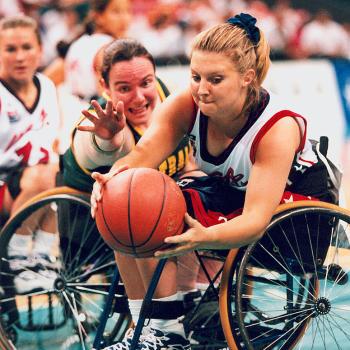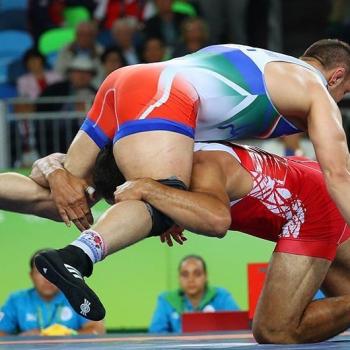New in JAMA: Research showing that children who view movies with gun usage in them are more likely to pick up and play with a real gun. The experiment was pretty simple: Children viewed a PG movie that either showed guns being used or had the gun-containing scenes edited out. The children were then left to play in a room full of toys, with a real but disarmed gun planted in the playroom.* After controlling for other variables, the researchers noted that children who had just viewed the gun-containing version of the movie were more likely to pick up the weapon and play with it.
This is not surprising research. Children learn. They act out in their play what they see around them. I’ll note here that the fact the gun was planted in a toy room was bound to cause some children to think it must be a toy gun.
Though firearms are not responsible for as many deaths among children under 12 than either drowning or automobile accidents, all the same: dead is dead. You don’t want your kid dying from any of these. That’s why we have to be obsessive about keeping young children from getting into the pool without adult supervision, for example, and making sure that when children are near water that the adult supervision is 100%. (Which is exhausting. There’s nothing easy and simple about keeping kids from drowning.)
The gun-viewing study, though, is interesting in that it offers such a simple way to reduce (not eliminate) childhood gun accidents: It’s not really necessary for children’s entertainment to contain gun scenes. I don’t say that because I’m one of those hyper-paranoid mothers who stores their child in an organic, passive-solar, spring-fed crate with three silk scarves to play with and a book about Our Silk Is Fair Trade. I say it because it’s possible for Hollywood to restrain itself. You could write scripts that don’t call for gun scenes.
And get this: You could have adult movies that didn’t show ridiculously irresponsible behavior with guns by people who ought to know better. How about . . . Don’t point your weapon at anything you don’t intend to shoot? Finger off the trigger until you are ready to shoot? I’d tell you to try a drinking game with Netflix where you drink every time you see bad gun safety practices, but I don’t approve of drunkenness either.
I’m not proposing we pass a law. I want no such law. What I’m predicting is that Hollywood will mostly not care.
Other Things You Can Do to Protect Your Kids
The researchers propose that parents be more particular about keeping their guns out of children’s hands, and I agree. Don’t store your firearms in a drawer in the kids’ playroom for certain. I jest, sort of, but yes, this is how it works:
- If you own a pool (bathtub, five gallon bucket . . .), you must be obsessively committed to keeping children from drowning in your water.
- If you own a motor vehicle, you must be obsessively committed to keeping children from being crushed to death by your vehicle.
- If you own a gun, you must be obsessively committed to keeping children from shooting themselves or others with your weapon.
Accidents can happen even when you are pretty impressively careful. People are fallible. Kids seem to gravitate towards the weirdest dangers sometimes. You cannot prevent every single accident ever. Bad things happen to good parents. But you can improve the odds. So definitely: Water safety, car safety, gun safety, all the other safety, as best you can manage.
Avoidance isn’t the Total Solution
Drinking, bathing, transportation, hunting, self-defense — these are all legitimate pursuits. The fact that they entail some level of danger doesn’t mean we need to eliminate them. So the other half of the equation is teaching your children how to stay safe. Teach them to swim. Teach them to buckle up, to not walk out into traffic, etc. And even though the research is discouraging, Stop, Don’t Touch, Run Away, Tell an Adult does sometimes work. I know that it works because there was a time it worked for my kid.
The boy was about four years old, and we were at our friends’ house. Our friends own guns, which they keep properly stored so that unauthorized users can’t access them. The adults were on site, and the children, including teens old enough to supervise a preschooler, were playing in the yard and garage (yard fenced; garage is used as a rec room / mud room, does not have dangerous tools, vehicles, etc. in it). In all ways this was a safe situation. Unless you’re going to have the crate with the three silks, you really can’t ask for a more reasonable level of safety.
The house, itself, though, was not crated off from civilization. Neighbors exist.
What happened is that the neighbor kid came over with his BB gun.
What happened next is that no one got hurt.
The reason no one got hurt is that our four year old boy bypassed Stop and Don’t Touch and went direct to Run Away and Tell an Adult. He was probably more impervious to the neighbor kid’s influence because (a) he didn’t know the kid (b) a teen is much more intimidating to a four-year-old than to a peer and (c) he didn’t know it was a BB gun. [Tip: BB guns do not cause very many deaths, but they can and do.]
Parents intervened, done.
Should you count on a four-year-old to reliably respond every single time? Of course not. But that doesn’t mean you give up and do nothing.
Safety training can help prevent injuries and death. I have a friend whose baby was saved from drowning by her little four- or five-year-old brother (I can’t remember the exact age — but it was dramatically young). How many times has a self-righteous sibling been the informant who let the driving parent know another of the children was unbuckled? I had one of my kids so firmly committed to buckling (by the age when she could climb into her own car seat and buckle herself reliably) that she’d yell, “I’m not buckled!” if you turned on the vehicle before she was fully buckled.
Teaching your kids good safety practices isn’t 100%. Nothing is 100%. Stuff is still gonna happen. You improve the odds by doing all the different things as well as you can.

Photo courtesy of Wikimedia [Public Domain], click through for the details.
*I think this study design is a terrible idea. Don’t model irresponsible gun habits. Kids should be able to trust that grown-ups aren’t going to put them in a room with a weapon like that. Honestly? I think causing a kid to have the experience of adults standing by watching (behind the glass) while the kids pick up a gun, point it at their playmate, and pull the trigger is unconscionable.












